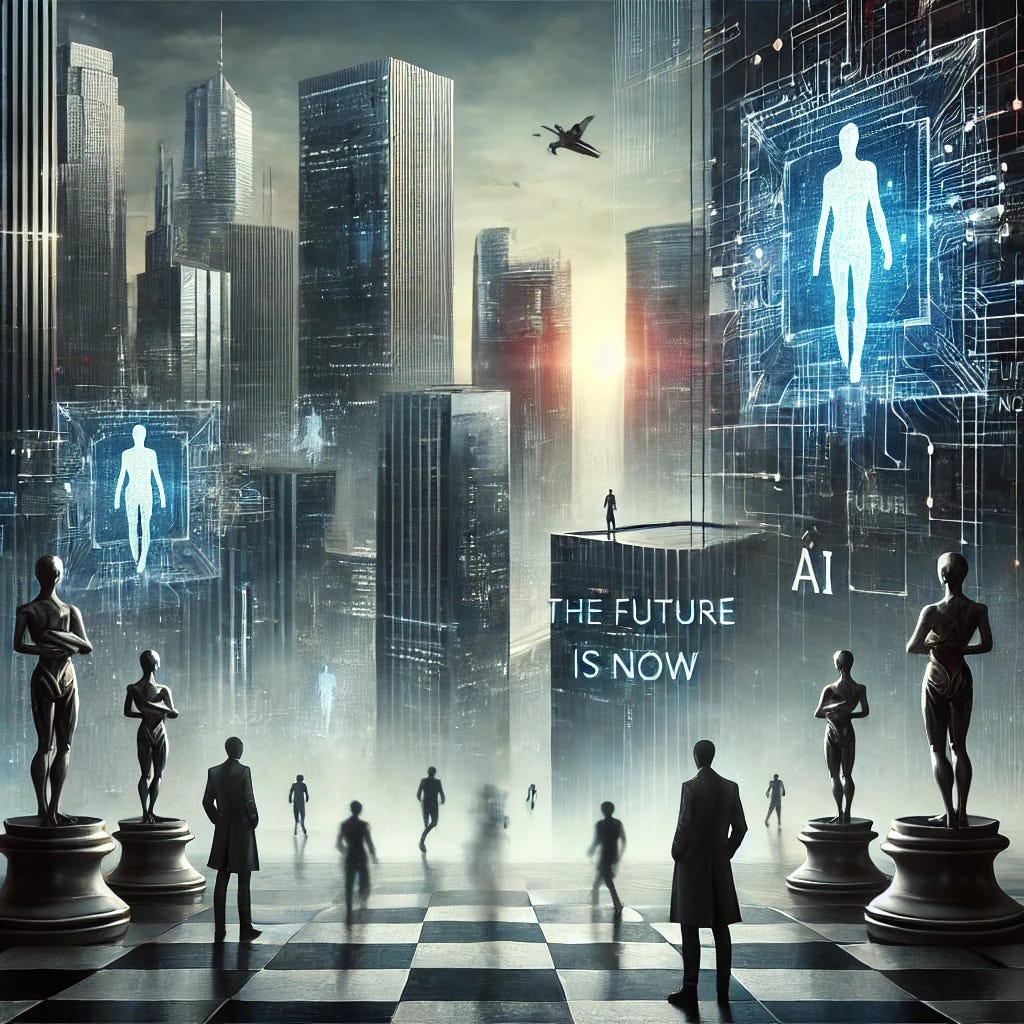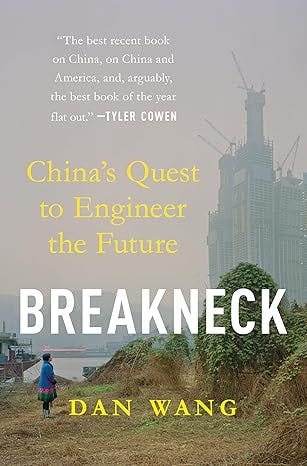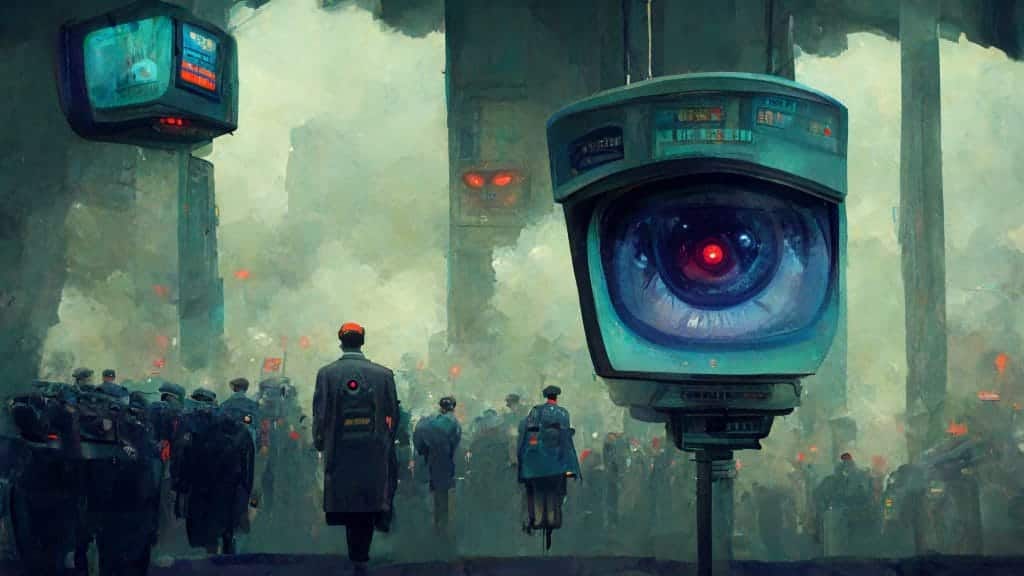Will the Next First Turning Be an American Technocracy?
The movement began in the 1930s. Today it has momentum, rapidly advancing technology such as AI, and billions of dollars to spend ... and a worldview in which human beings are akin to cattle.
First Turning?
Our present Fourth Turning is probably in its final phase, with America’s (and most other Western nations’) political economy FUBAR and losing credibility day by day, its institutions hollowed out and increasingly dysfunctional, incompetent clowns like Pete Hegseth and Kristi Noem in charge of vast federal agencies, and AI threatening to decimate the workforce while making the billionaire class richer. Multiple crises, for sure!
Reviewing as briefly as possible: the Strauss-Howe thesis, first presented in The Fourth Turning (1997), proposed that history can be seen in terms of cycles roughly the length of a human life span (70 to 80 years), each cycle divided into four Turnings. The First Turning of any cycle is a High, characterized by strong institutions and weakened individualism. Its Second Turning is an Awakening, during which institutions’ core assumptions get called into question. A Third Turning, an Unraveling, sees weakened institutions and unleashed do-your-own-thing individualism. The Fourth Turning is a Crisis, often beginning with a systemic shock such as a financial meltdown (think: 2008).
A Crisis either resolves itself and redefines a society, or the society itself melts down. I don’t think we’re going to melt down, because of those with the money, power, and motivation to hold things together — on their terms. That will mean a redefinition of essentials. Crises do that. At the end of past Crises, America’s self-conception had changed wholesale. Arguably, at the end of the Crisis that culminated in the War Between the States, the U.S. had ceased to be a federation of states and became a nation-state on a par with those of Europe. During the next Crisis — the Great Depression — FDR put forth the New Deal; Bretton Woods was established during the next decade; the Allies won the Second World War. The nation-state emerged as the presumed leader of the free world, its currency the world’s reserve currency.
That was 80 years ago. How will our present Crisis resolve? What will the next First Turning look like?
It’s hazardous to attempt an answer. Would the struggling unemployed of the mid-1930s have been able to imagine what would emerge during the 1950s? At the time, it probably seemed like we’d hit a brick wall. Just as it seems to many of us today.
Be that as it may, I’ll try. Or perhaps, warn, just in case we don’t want this particular future and are still motivated to want to prevent it.
Technocracy.
What is Technocracy? The best online overview I’ve found to learn about Technocracy is here, and I highly recommend Patrick Wood’s very affordable short course.
The basic idea, according to Technocracy’s own literature dating from the 1930s, is “the science of social engineering”: the building of a scientifically managed society, run not through a political process as we understand it but by trained “experts”: scientists, engineers, technicians, and layers of managers. Etymologically, the term derives from two Greek words, tekhne, meaning skilled as is a craftsman or with systems; and kratia, meaning rule or power or governance.
The word appears to have been coined by William Henry Smyth, an engineer living in Berkeley, CA, who penned a series of articles for New York based Industrial Management in 1919. He argued that America needed a Supreme National Council of Scientists to advise on how to realize our aspirations and national purpose. It is worth noting that the country was amidst an Unraveling: Great War (First World War), Roaring 20s, The Great Gatsby, Dadaist art, flappers, and all that.
It would be during the Crisis — the Great Depression — that Howard Scott and M. King Hubbert would found Technocracy Inc., basing it at Columbia University, housed on a floor they shared with then-fledgling IBM. Their magazine Technocracy Now proposed educating and empowering a public movement that would scrap existing institutions and appoint scientists and other “experts” to run the country in top-down fashion. The organization reached a dues-paying membership of 500,000. It drew on diffuse sentiment that democracy had failed and that it was time to try something else, something outside the spectrum of ideologies such as fascism and communism which Technocrats despised. Politicians, interestingly, were refused membership.
During the High that began in the late 1940s, Technocracy was forced underground. The word itself became verboten at Columbia. But the impulse behind it survived, and reemerged beginning with Zbigniew Brzezinski’s Between Two Ages: America’s Role in the Technetronic Era (1970). David Rockefeller read that book, and with Henry Kissinger — Nixon’s then Secretary of State — organized the Trilateral Commission which proposed a New International Economic Order pursuing essentially what Technocracy Inc. had pursued. Trilateral Commission members have dominated every presidential administration since, Republican or Democrat.
Technocracy also emerged in the Sustainable Development movement, which proposed to control all natural (and human) resources, transforming existing communities into so-called “smart cities” ostensibly in the name of saving the planet from the scourge of unplanned industrialism and “suburban sprawl.” According to its founding body the Brundtland Commission, Sustainable Development was defined as:
“Development that meets the needs of the present without compromising the ability of future generations to meet their own needs.”
Thus began a plan to catalogue, monitor uses of, and control all natural (and human) resources, the program originally called Agenda 21 and now called Agenda 2030. Through these, Technocracy survived into the 2000s.
It is very much around today, and more powerful than ever!
Go back to the 1930s. A chiropractor named Joshua Haldeman based in Regina, Saskatchewan, had undertaken the task of leading Canada’s branch of Technocracy Inc. The Canadian government saw the effort, which ultimately sought to unite Canada and the U.S. (and Mexico and Greenland) into a North American Technate, as subversive. Haldeman was called out for it. He fled to South Africa, married, had children including Maye Haldeman who married Errol Musk — who became the father of none other than Elon Musk who grew up in a Technocrat household, became the world’s richest man, and says he’s “building the future.”
Today’s billionaire class, operating out of Silicon Valley and elsewhere along the West Coast, has a Technocrat mindset. Think of Bill Gates’s global efforts, in partnership with the World Economic Forum, where Klaus Schwab used the phrase Fourth Industrial Revolution combining technology, genetics and neuroscience, the view of human beings as human resources (or human capital), and the “reinvention” of government which had become a buzzword during the Clinton years.
Peter Thiel, Alex Karp, Reid Hoffman, “Mencius Moldbug” (Curtis Yarvin), Nick Land, and countless others in that environment, developed concrete proposals (such as Yarvin’s neocameralism and Land’s Dark Enlightenment) of how society should be reordered along Technocrat lines — whether or not they use that term.
Fast forward to 2024. Musk bought Twitter, changed its name to X, converted it to a Trump-friendly platform. He donated at least $250 million to Donald Trump’s campaign to retake the White House. Thiel schooled J.D. Vance, which may be what changed Vance from the anti-Trumper who authored Hillbilly Elegy to the pro-Trumper who became Vice President. This was after his founding Palantir, now the leading corporate leviathan supporting the surveillance-and-control state with technology including AI.
Note how Trump, a billionaire himself who inherited the bulk of his wealth, has always been surrounded by billionaires — and even more so now, with Jeff Bezos and Mark Zuckerberg on board despite their opposition to his reelection back in 2020. What’s changed? The realization by Technocrats that they could hijack this administration; and as I’ve argued previously, they have.
Next, note Trump’s gestures toward making Canada “the 51st state,” taking Greenland from Denmark (by force, if necessary), and reclaiming the Panama Canal: all 1930s goals of Technocracy Inc. Back then, they had no idea how to go about it. With technology and economic integration, that’s changed wholesale.
Note, finally, the dysfunction I described at the outset, much of which is probably planned (these people are not stupid, after all!), the realization that sooner or later the masses will demand it stop and turn to those who promise a fix, and that is when Technocrats will step up openly.
We come to the question of the hour: is Technocracy our future — the next First Turning, or High, resolving present Crises to the satisfaction of the dominant actors?
Would a dysfunctional society fall willingly into the grasp of a “scientific” elite that promised salvation? The movement has momentum, rapidly advancing AI behind it, and billions of dollars to spend, as well as developing central bank digital currencies (CBDCs) and the possibility of Universal Basic Income (UBI) as a “cure” for the technological unemployment caused by AI.
Moreover, American Technocracy has a model to follow.
The Case of China.
An article on left-leaning Vox.com showed up in one of my feeds late last month: “Why China Can Build So Quickly and America Can’t,” by Sean Illing, reviewing a new book I haven’t read entitled Breakneck: China’s Quest to Engineer the Future, by Dan Wang, interviewing its author.
As much as we may badmouth China — or observe that China got built to where it is today courtesy of the West’s stupid trade policies — the bottom-line is: China has built a tremendously efficient national infrastructure in a matter of a few short decades, while America’s infrastructure is falling apart. The Chinese can get things done. We can’t. Why not?
Illing provides Dan Wang’s answer:
… one of the most important distinctions between the U.S. and China is that the U.S. is a society run by lawyers and China is a society run by engineers….
China … is an engineering state. At times, the entire Standing Committee of the Politburo, the country’s top leadership, was filled with trained engineers. Hu Jintao, for example, was a hydraulic engineer who supervised the building of a dam. His premier, Wen Jiabao, was a geologist. They approached society as if it were a giant technical problem, something to be solved like a hydraulic system or a math equation.
That’s Technocracy in a nutshell! Add only the idea that populations can be treated the same way, with the state using incentives and disincentives as structural coercion designed to ensure desirable forms of mass behavior, and you have the basis of China’s social credit system.
Wang continues:
America, by contrast, began as a lawyerly society. The Declaration of Independence reads like a legal case. Many of the Founding Fathers were lawyers, and so were the vast majority of presidents up through Lincoln. Even today, lawyers are dramatically overrepresented in politics and business. The Biden White House was famous for its Yale Law grads….
[T]he Anglosphere in general has this tradition: skilled debaters rising into political power. Lawyers dominate not just politics but corporate leadership, too. Even President Donald Trump, though not a lawyer, governed in a lawyerly way — suing people constantly, using accusations in the court of public opinion. His vice president, J.D. Vance, is also a Yale Law product.
This difference is crucial for understanding what will happen if a takeover of the English-speaking world — and Europe — by Technocrats is what characterizes the next First Turning, or High.
Chinese authorities can mandate a big project, such as a bridge or an airport or a high-speed rail system or an entire city. Beijing will then pour money into it, and the project happens. No discussion, debate, deliberation. Just top-down mandates and action. “That’s what the engineering state does,” says Wang.
We have not operated that way in the West — or tried not to. It has been clear that the methods may be efficient but the results eventually turn inhumane. The Western ethos, based on the Christian worldview, is that persons have intrinsic value as creations by God, all with unique purposes in serving Him. That’s been the moral foundation of our presumed right to direct our own lives while allowing others that same right.
China, since Mao, has been officially atheist — nominal Christian churches are permitted, but only if they conform to rigid dictates handed them by the CCP. The result is that persons have no intrinsic value but rather belong to the state. Wang explains:
… Beijing … treats populations as if they can be managed like values in a hydraulic system. Ethnic minorities in Tibet and Xinjiang face detention camps and forced assimilation. For the majority population, the hukou system has long restricted movement.
And then there’s the one-child policy…. In 1980, Deng Xiaoping empowered engineers to shape policy, and one brilliant mathematician from the missile industry convinced him that population trajectories could be managed like missile trajectories. The result was decades of forced sterilizations and abortions.
The official number is over 300 million abortions during the one-child era, the equivalent of the entire U.S. population. Rural women were terrorized. Children were taken from mothers or beaten out of them. It was an idiotic policy pursued with staggering brutality.
In China, the CCP pushed Technocracy, and even more so after the Soviet Union collapsed and it became clear: communism as it had previously understood itself was dead.
In the U.S., billionaire-owned corporations such as Google and Palantir are leading the way towards a total-information and a total-surveillance state respectively. Social media is part of this. Users volunteer their personal information, employment history, daily doings — often including their political activity. It’s all being collected in vast data centers still being constructed, with AI able to organize information millions of times faster than any human.
An American variation on social credit would involve introducing programmable CBDCs — the most likely response to the next debt-induced financial meltdown — about which plenty of warnings have been sounded (by myself and others). They might involve UBI, the most logical response to mass layoffs precipitated by mass corporate embrace of AI in the name of greater profits. Money and the need for it is already fundamentally a system of social control. Technocracy takes that to the next level.
We already have mass surveillance using facial-recognition technologies. Corporations could employ AI in ways we haven’t seen yet, as the digital cage descends on a mostly unsuspecting population. The fact that solitary and lonely people have become addicted to ChatGPT chatbots programmed to simulate empathy carries with it some strong possibilities of how AI could be used to control people willingly, just as people give their information to social media platforms willingly.
So would we really call this the next High? The last high — the 1950s — was overall a time of great optimism. Some of that optimism survived into the 1960s. What we’ve portrayed here is surely Dystopia!
It’s not impossible, though, that a full Technocracy could unleash a wave of productivity able to create a lot more abundance than we have now. Those who choose to cooperate might well perceive their problems as having been fixed. They might not have many choices of occupation, with robots doing all the work, but they’d have food on their tables, a roof over their heads, utilities paid, and doubtless plenty of streaming entertainment. They would “own nothing, have no privacy, but life would never have been better.”
Let’s recall what characterizes a High: strengthened institutions, weakened individualism, with a strong loyalty to “the system” and its core values. These would include demands for conformity and submission to the digital control grid, not dissimilar to that which exists in present-day China. Records would be kept of all your online activities, and if you express opinions that flout approved narratives, your CBDC / UBI could simply be turned off. You couldn’t legally buy food or pay those utilities or stream those subscription-only shows.
There would probably be outsiders, though: an underground of untouchables. Just as the standard description of the High of the 1950s doesn’t include, say, the Beat Generation (Jack Kerouac, William Ginsberg, William S. Burroughs, etc.), they wouldn’t be talked about except in whispers. Obviously, there was no digital cage back in the 1950s. But I doubt that any system will be able to control everyone. I can see those accused of thought crimes as defined by the new order sent to isolated places and be made/allowed to fend for themselves, rather like Mr. Savage of Huxley’s Brave New World.
Being such a person during the next First Turning should it turn to Technocracy would engender an existence of precarity and danger. Think of the characters in Neal Stevenson’s frightening cyberpunk novel Snow Crash.
Is Technocracy Stoppable?
Technocracy is the most logical and probable consequence of a civilization that had been making progress, moral as well as scientific and technological, but along the way was stripped of its moral compass.
The result: progress continued, but amidst ambiguity at best and total subjectivism at worst. This began, as such things typically do, in the intellectual centers. It spread through the arts, literature, social sciences, public education; and finally, through mass media and entertainment sectors, to every sector of society. Moral subjectivism enables, and often encourages through abundant examples (celebrities), hedonistic and destructive lifestyles and subcultures of do-your-own-thing, self-actualize in your own way, while portraying Christians as backward, intolerant, and cruel, because they maintain moral absolutes.
Some variants on this theme, such as voluntaryism (similar to libertarianism), emphasize as a quasi-absolute that all human interactions should be voluntary and none coerced. But such injunctions have no teeth in them, and no realism. The psychopaths in our midst know how to exploit them to achieve their goals. Libertarianism, it became clear to me some time ago, is akin to neoliberalism in shifting societal controls from state to corporations, leaving those of us without enormous sums of money worse off than we are now. Unfettered markets redistribute wealth upwards and consolidate it. This is structural. You get a billionaire class which does as it pleases, its members answering only to each other, because they can. This includes buying the political class and hijacking presidencies. Money and power are akin to gods in a system built up without God or any sense of responsibility to the Transcendent.
Back in the early to mid-1800s, Auguste Comte, founder of sociology and the philosophical ideology known as positivism, posited his Law of Three Stages: the first stage or state of civilization is the “religious or fictitious.” The second is the “metaphysical and abstract.” The third is the “scientific and positive”: empirical, technological, utilitarian. Comte didn’t think that in relegating God to the first stage ash heap, he was throwing out morality as well as it had been understood for the past 2,500 years. There is no “scientific method” for determining the truth or falsity or even meaningfulness of moral claims. Nietzsche wasn’t around yet to inform Comte of the consequences of positivist-grounded materialism. Comte and his intellectual heirs — Wilhelm Wundt, Edward Thorndyke, John Dewey, Edward Louis Bernays, and B.F. Skinner all come to mind as proto-Technocrats — laid the groundwork for the social engineering program which Technocracy would formalize. These people saw human beings as sophisticated animals — like cattle or sheep — differing in complexity but not in kind from the rest of the animal kingdom. Thus the absence of moral qualms about cataloguing them, herding them, using them as tools (“human resources”) by those with the right techniques.
And expendable if inconvenient.
The only way to prevent this kind of High and thwart Technocracy, in that case, is to reject the materialist / atheist / positivist axis and worldview, because Technocracy — the “science of social engineering,” i.e., “scientific” totalitarianism — is the telos of such a worldview which places no limits, intrinsic or extrinsic, on the exercise of power by an amoral few in a position to wield it. This rejection cannot be merely intellectual. It must be cultural and organic, baked into new institutions and not simply presented didactically as I’ve had to do here.
This is a tall order. Since I’m a resourceless nobody who writes for free on Substack — no institutional affiliation, no money, no connections that amount to anything — I’m open to suggestions on how best to do this, because one thing is for sure: we’re rapidly running out of time!
_________________________
Steven Yates is a (recovering) ex-academic with a PhD in Philosophy. He taught for more than 15 years total at several colleges and universities in the Southeastern U.S. He has authored three books, more than 20 articles, numerous book reviews, and review essays in academic journals and anthologies. Refused tenure and unable to obtain full-time academic employment (and with an increasing number of very fundamental philosophical essays refused publication in journals), he turned to alternative platforms and heretical notions, including about academia itself.
In 2012, he moved to Chile. He married a Chilean national in 2014. Among his discoveries in South America: many of the problems in the U.S. are problems everywhere, because human nature is the same everywhere.
He has a Patreon.com page. Donate here and become a Patron if you benefit from his work and believe it merits being sustained financially.
Steven Yates’s book Four Cardinal Errors: Reasons for the Decline of the American Republic (2011) can be ordered here.
His philosophical work What Should Philosophy Do? A Theory (2021) can be obtained here or here.
His cosmic horror novel The Shadow Over Sarnath (2023) (written for the sheer fun of it) can be gotten here.
SPECIAL NOTE: Steven Yates’s new book So You Want to Get a PhD in Philosophy? will be published in later this month.
Should you purchase any (or all) books from Amazon, please consider leaving a five-star review (if you think they merit such). Readers notice, and so does the Amazon algorithm.








Great post, Steve!
Fantastic article!! I’m so glad you mentioned the linertarians and voluntaryists. I know many of them mean well and think they are “rebelling the state in favor of ‘freedom’”, but they are sadly marching head first into the technocracy control grid and they don’t even know it or understand why! Freedom and free will are not the same! One is an end and often a collectivist end. Freewill is a beautiful gift from the creator who designed humans as rational beings with the capacity to adjudicate morality and endowed us with freewill as a vehicle to pursue virtue and morality!
Many of the libertarians and voluntaryists are advocating for network states claiming they are championing freedom, while being ushered into techno-feudal fiefdoms ruled by smart contracts programmed by the tech oligarchs!! Libertarianism (and similarly voluntaryism) are largely predicated on Lockean contractarian principles despite many of them claiming to advocate natural law. It’s not rooted in natural law because the metaphysics are constructivist and self-apotheotic rather than rerum natura (in the nature of things) predicated on a created order and and ontological framing that views humans as endowed with free will —imago dei.